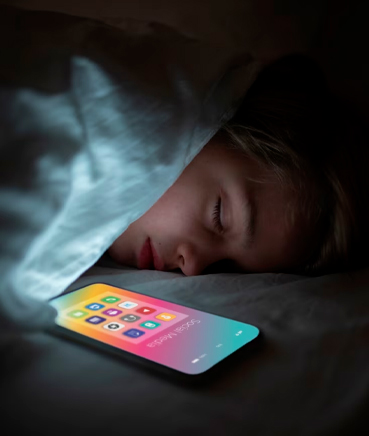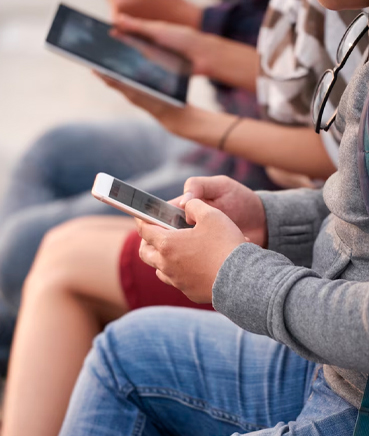Understanding the influence of excessive screen use on the mental health of adolescents. As the digitalization of society accelerates, this article aims to analyze how time spent in front of screens affects the psychological well-being of young people. From the nuances of social media use to smartphone addiction to effective therapies for digital compulsions, discover the latest research and perspectives to understand and address this modern issue.
Mental health in the digital age
Impact of screens on adolescent mental health
Teenagers' screen time raises concerns about their mental health.
Studies on the exact impact of screen time on mental health have yielded mixed results.
use may be associated with an increased risk of depression , particularly among girls.
"Not all addictions have their roots in abuse or trauma, but I think they can all be linked to painful experiences. Pain is at the heart of all addictive behaviors." -Gabor Mate
In an age where digital devices and social media are an integral part of daily life, especially for adolescents, it is essential to understand their impact on mental health. The rise in Internet use among adolescents around the world is remarkable, with 79% of people aged 15 to 24 being active users. This demographic spends on average more than six hours a day on screens, engaging in activities ranging from social media to gaming.
However, the picture that emerges is contrasting and contradictory. Large-scale studies in the UK and US have shown that the link between screen time and mental health is minimal. Yet a comprehensive analysis of 50 articles published in 2023 found significant associations between screen exposure and mental health problems among adolescents, particularly regarding weekday smartphone use and its correlation with decreased mental well-being. The impact of social media is also complex, with some users, particularly girls, at higher risk of depression related to their use.
The addictive potential of smartphones and the internet is increasingly worrying. Phone addiction is not a diagnosis in the DSM-5. Nonetheless, indicators of compulsive use include a preference for the virtual world over real-life interactions, negative reactions to being offline, and neglecting important responsibilities. The shift from pleasure to compulsion in the digital world is akin to substance abuse and neurochemical reactions. The release of dopamine plays a crucial role.
The compulsion often begins with the pleasure derived from online activities, but it can progress into a harmful addiction, particularly when it begins to control behavior and daily life. In the digital age, we find ourselves in a world where the internet reigns supreme. This is an area where pleasure has no limits. Hours spent scrolling social media, binge-watching TV, or simply clicking on cat videos may seem harmless at first glance. But for many, these activities can turn into compulsions, driven by the incessant search for pleasure. Neuroscience seems to illuminate the paradoxical relationship between pleasure and control; they demonstrate that when we try to abstain from these digital indulgences, it often intensifies the craving, creating what is known as the "forbidden fruit" phenomenon. Our brains are wired to seek pleasure, even when we know it's not in our best interest.

Book an in-office consultation in Paris Montorgueuil or remotely by videoconference
We receive our patients from Monday to Friday.
To make an appointment you can call us on +33 (0) 1 48 07 40 40
or +33 (0) 6 03 24 81 65 or even make it directly online
by clicking here:
The power of pleasure
In her book Dopamine Nation, Dr. Anna Lembke demonstrates that the search for pleasure, mediated by the neurotransmitter dopamine, can lead to addiction when this search disrupts the brain's natural balance between pleasure and pain. She explains that engaging in activities that release dopamine can lead to a compensatory increase in pain sensitivity, creating a cycle where one seeks out more dopamine-inducing activities to compensate for this discomfort.
This theory highlights the delicate balance between pleasure and pain in the brain's reward system and how its disruption can underlie compulsive behaviors. Pleasure is an enigmatic force that we all experience, but do we really understand how it influences our behaviors and decisions? Pleasure is a fundamental aspect of human existence, one that has captivated philosophers, psychologists, and neuroscientists for centuries.
From use to abuse
From the moment we are born, the search for pleasure is written into our DNA. Remember your childhood: the endless hours of play, exploration and laughter were essential. Abraham Maslow, a renowned psychologist, said that once our basic needs such as food and shelter are met, we embark on a quest for higher needs, including the search for joy. Play, in all its forms, becomes our gateway to pleasure.
Ancient civilizations understood the importance of play in a person's life. Take the example of ancient Greece, where different forms of play were considered essential to the well-being of every citizen. Whether sports, theater, or philosophical debates, the Greeks recognized that these activities not only provided pleasure, but also a sense of purpose and belonging.
The fun doesn't stop at the game; it also acts as a soothing balm in times of distress. When life throws surprises at us, we turn to activities that comfort and relieve us. Neuroscientists have explored the brain's reward system and highlighted the link between pleasure and calming. Even in the case of self-injurious behaviors, such as cutting or scratching, these actions may have initially served to relieve psychological pain, but over time they can take a surprising turn, providing not only relief but intense pleasure . It's a puzzling phenomenon that reveals the complex interaction of our brain's circuits.
The addiction
The shift from regular to problem drinking occurs when pleasurable experiences become compulsive, leading to a loss of control. At the heart of pleasure is the brain's reward system, governed by neurotransmitters like dopamine and endorphins. Pleasure motivates essential behaviors such as feeding and mating, and dopamine is released through the brain's reward pathways, which reinforces beneficial activities and influences learning and memory. Endorphins, another group of neurotransmitters, reduce pain and increase well-being; they are often released during activities aimed at relieving stress. The interaction of these neurotransmitters in brain regions such as the nucleus accumbens and prefrontal cortex underlies the multifaceted nature of pleasure.
Addiction occurs when the absence of pleasurable experiences triggers withdrawal symptoms, which are only relieved by resuming the behavior. Anticipation of pleasure triggers a cascade of neurochemical events. Adrenaline intensifies excitement, leading to the production of endorphins, and makes difficult tasks easier. Addiction relies on these neurochemical processes and highlights the profound role of pleasure in shaping everyday human behavior. is essential to addressing the compulsion and developing effective intervention strategies.

The person behind the screen
The role of individual vulnerabilities and real-life social experiences in shaping a person's relationship with social media is essential. Psychologist Lucy Foulkes points out that people who are particularly anxious about being liked on social media often have pre-existing concerns about appearance and social approval. Additionally, the vast majority of young people who experience cyberbullying may also face real-life bullying. It is therefore essential to understand the individual behind the screen to grasp the true impact of social media on mental health. Despite concerns over its impact, social media has undeniable benefits, particularly highlighted during the pandemic as a crucial tool for communication and connection. They play a fundamental role in modern socialization, particularly for young people, by facilitating the exploration of personal identity and providing opportunities for positive interactions. The challenge is balancing these benefits with potential risks, and understanding the nuances of individual experiences of users of these platforms.
Fight the compulsion
Ultimately, recovery from compulsive internet and smartphone use requires more than just changing behavior. We need a profound transformation of the individual's relationship with their digital habits. It’s not enough to reduce screen time; We also need to change the way people understand why they use digital devices excessively and how they relate to the digital world. In fact, when we approach the issue of compulsion, it becomes clear that it goes beyond the individual and is significantly influenced by various systems and factors of our "digital age." Just as a healthy relationship with the digital world depends not only on the individual, but also on the societal, cultural and technological environment, managing the compulsion linked to the use of the Internet and a smartphone requires a global approach.
Therapy has been shown to be effective in treating online compulsions (Portelli and Papantuno, 2017) and effective therapy involves helping individuals recognize their compulsion and regain control over their use.
Techniques include interval training to delay responding to notifications and reducing app usage to encourage healthier habits. Effective therapy emphasizes the importance of understanding the needs and motivations of the individual, guiding them toward reclaiming a life beyond the digital world. The relationship between screen time, social media, and adolescent mental health is a complex and evolving issue. It requires a nuanced understanding of individual experiences, vulnerabilities and the socio-digital environment in which they operate. While recognizing the potential risks, it is equally important to recognize the benefits that these digital platforms offer, including fostering connections and assisting in identity formation during crucial stages of development.
Where to train in the systemic and strategic approach?
LACT offers several live certifying web training courses with 50 international trainers.
- Generalist systemic training
- DU in Relationship Clinic with the University of Paris 8
- Clinical Masters with specialization in psychopathology with Pr Nardone's CTS
- Systemic Coach Training
- Systemic training in relationship management with the University of Grenoble
- Online Ericksonian Hypnosis Training
I would like to consult for obsessive compulsive disorder (OCD)
References
- BMC Psychology. (2023). The associations between screen time and mental health in adolescents: a systematic review. Taken from
- Gibson, P. (2022). Principle of persuasion. Strategic communication for influence and persuasion. Strategic Science Books.
- Gibson, P. (2021) Escaping the Anxiety Trap. Strategic Science Books.
- Gibson, P. (2022). Persuasion Principle. Strategic Science Books.
- Gibson, P, Manzoni, M., Pietrabissa (2014) A 4-year Observational Study on the efficacy of BST Treatment for OCD in an Irish Clinic. Journal of Therapies in Medicine.
- https://bmcpsychology.biomedcentral.com
- International Telecommunications Union. (2023). Facts and figures 2023 - Internet use by young people. Retrieved from https://www.itu.int
- Lembke, A. (2021). Dopamine Nation: Finding Balance in the Age of Indulgence. Dutton.
- Papantuono, M. (2007). Identifying and exploiting patient resistance to change in brief strategic therapy. Brief Strategic and Systemic Therapy: The American Review, 1(1).
- Papantuono, M., Portelli, C. and Gibson, P. (2021). Winning Without Fighting: Techniques and Strategies for Resolving Social, Emotional, and Behavioral Difficulties in Children and Adolescents. San Paolo, Milan.
- Papantuono, M., & Portelli, C. (2008). Brief strategic and systemic approach to cannabis dependence: Involving the family system to overcome adolescent cannabis addiction. Journal of Brief, Strategic, & Systemic Therapies, 2(1), 2-12.
- Papantuono, M. and Portelli, C. (2008). Cannabis addiction. In B. Skorjanec (Ed.), How to quit smoking (pp. [page range]). Milan: Ponte alle Grazie.
- Papantuono, M., & Portelli, C. (2011). Theory & Clinical Practice Brief Strategic-systemic approach to cannabis addiction. Journal of Brief, Strategic, and Systemic Therapies, 2(1). American Association of Brief & Systemic Therapists.
- Papantuono, M. and Portelli, C. (2017). New addictions: Recognize them, understand them, overcome them. San Paolo, Milan.
- The Tech Report. (2023). 50+ Screen Time Statistics and Facts in 2023. Retrieved from https://techreport.com
- University of New Hampshire Extension. (2023). The Impact of Social Media on Youth Mental Health. Retrieved from https://extension.unh.edu





